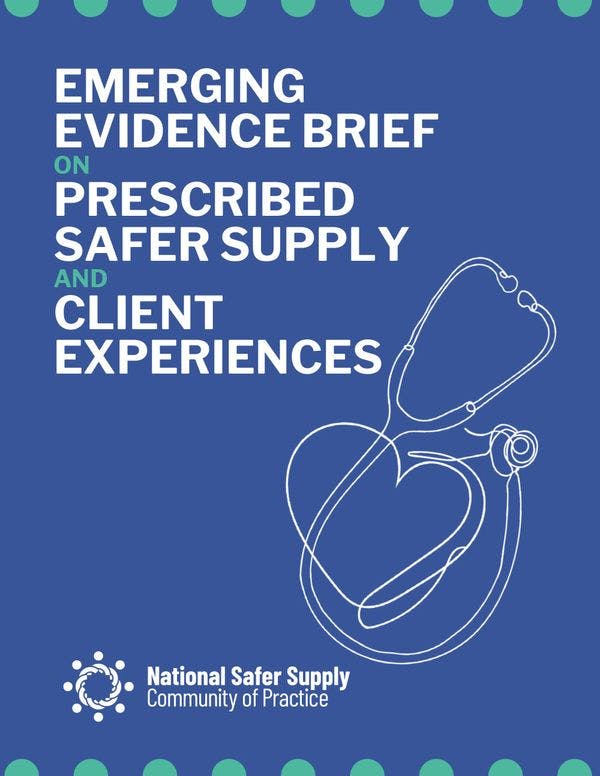Programmes d'approvisionnement sécurisé sur ordonnance : de nouvelles données probantes
12 mai 2023
National Safer Supply Community of Practice
La National Safer Supply Community of Practice suggère que ces programmes réduisent le nombre de décès et d'overdoses, favorisent le maintien dans les soins et améliorent un grand nombre de résultats en matière de santé physique et mentale. Pour en savoir plus, en anglais, veuillez lire les informations ci-dessous.
What does the evidence show?
Initiators of prescribed safer supply in Canada have drawn on the extensive literature on international OAT studies, European Heroin Assisted Treatment (HAT) studies and Canadian iOAT. There are many research and evaluation studies underway, with evidence emerging to show:
- Prescribed hydromorphone is not contributing to drug-related deaths: Data from coroners in both BC and Ontario have found no link between prescribed hydromorphone and drug-related overdose deaths: “There is no indication that prescribed safe supply is contributing to illicit drug deaths” (British Columbia Coroners Service, 2023). In Ontario, despite the increasing use of immediate-release hydromorphone during the early pandemic period, both the percentage and overall number of hydromorphone-related deaths actually decreased (Gomes et al., 2022).
- Reduced risk of death and/or overdose: Both drug-related deaths and deaths from any cause among people receiving prescribed safer supply were rare (Young et al., 2022; Gomes & Kolla, 2022) and they had fewer overdoses (Atkinson, 2023; ESCODI, 2022; Haines et al., 2022; McNeil et al., 2021; Selfridge et al., 2020).
- Engagement and retention in programs and care: Increased access to health and social services, including primary care, COVID-19 quarantine, OAT, counselling, and housing support; and improved relationships with providers (Atkinson, 2023; Brothers et al., 2022; Haines & O'Byrne, 2023; Kolla et al., 2022; McMurchy & Palmer, 2022; Selfridge et al., 2020; Selfridge et al., 2022).
- Improvements in physical and mental health: Improved chronic and/or infectious disease management, medication adherence, pain management, sleep, nutrition, and energy level (Haines & O'Byrne, 2023; Kolla et al., 2022; Klaire et al., 2022; Ivsins et al., 2021; McMurchy & Palmer, 2022; Haines et al., 2022; Selfridge et al., 2020; Gomes & Kolla, 2022).
- Fewer emergency department visits and hospitalizations: Significantly fewer Emergency Department visits and inpatient hospital admissions after entering the safer supply program compared to the year prior, with no change in these outcomes among a matched group unexposed to safer supply in the same time period (Gomes, Kolla, McCormack et al., 2022).
- Decrease in hospitalizations for infectious complications: In the year after beginning a safer supply program, there was a significant decrease in hospitalizations for infectious complications among safer supply clients; hospitalizations dropped from 26 in the year before program entry to 13 in the year following entry to a safer supply program (Gomes, Kolla, McCormack et al., 2022). There was no change in these outcomes among a matched group unexposed to safer supply in the same time period (Gomes, Kolla, McCormack et al., 2022). Increasing infection rates overall among people who inject drugs since 2016 align with the shifts in the unregulated drug market towards nonprescription fentanyl (Gomes et al., 2021).
- Reduced use of drugs from the unregulated street supply (thereby reducing overdose risk) and, in some cases, reducing drug use overall or ceasing the use of drugs by injection (Atkinson, 2023; Kolla et al., 2022; McNeil et al., 2021; ESCODI, 2022; Haines et al., 2022; Selfridge et al., 2020; Ivsins et al., 2020b).
- Improved control over drug use: The flexibility and autonomy of prescribed safer supply programs, coupled with certainty about dose strength, enabled participants to avoid withdrawal symptoms and manage pain (Haines & O'Byrne, 2023; McNeil et al., 2021; Ivsins et al., 2020b, Selfridge, 2020).
- Improvements in social well-being and stability: Economic improvements (Ivsins et al., 2020; Selfridge et al., 2020; Haines et al., 2022), reduced inequities stemming from the intersection of drug use and social inequality (Ivsins et al., 2021), better control over time leading to engagement in employment, hobbies, and interests (Atkinson, 2023; McMurchy & Palmer 2022; Haines et al., 2022), decreased involvement in and exposure to violence, criminal activities and legal issues (Haines & O'Byrne, 2023; Kolla et al., 2022; McMurchy & Palmer, 2022; Haines et al., 2022; Ivsins et al., 2020b), improved general social stability (ESCODI, 2022), improved housing access (Atkinson, 2023; Haines et al., 2022) and improved relationships with family members and friends (Kolla et al., 2022; McMurchy & Palmer, 2022; Selfridge et al., 2020 ).
- Decline in health care costs: Prescribed safer supply program participants had lower costs for healthcare not related to primary care or outpatient medications in the year after program initiation, with no corresponding change observed in a matched group of individuals who did not access the program (Gomes & Kolla, 2022).
